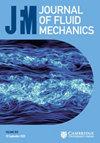Shear-induced depinning of thin droplets on rough substrates
IF 3.9
2区 工程技术
Q1 MECHANICS
引用次数: 0
Abstract
Depinning of liquid droplets on substrates by flow of a surrounding immiscible fluid is central to applications such as cross-flow microemulsification, oil recovery and waste cleanup. Surface roughness, either natural or engineered, can cause droplet pinning, so it is of both fundamental and practical interest to determine the flow strength of the surrounding fluid required for droplet depinning on rough substrates. Here, we develop a lubrication-theory-based model for droplet depinning on a substrate with topographical defects by flow of a surrounding immiscible fluid. The droplet and surrounding fluid are in a rectangular channel, a pressure gradient is imposed to drive flow and the defects are modelled as Gaussian-shaped bumps. Using a precursor-film/disjoining-pressure approach to capture contact-line motion, a nonlinear evolution equation is derived describing the droplet thickness as a function of distance along the channel and time. Numerical solutions of the evolution equation are used to investigate how the critical pressure gradient for droplet depinning depends on the viscosity ratio, surface wettability and droplet volume. Simple analytical models are able to account for many of the features observed in the numerical simulations. The influence of defect height is also investigated, and it is found that, when the maximum defect slope is larger than the receding contact angle of the droplet, smaller residual droplets are left behind at the defect after the original droplet depins and slides away. The model presented here yields considerably more information than commonly used models based on simple force balances, and provides a framework that can readily be extended to study more complicated situations involving chemical heterogeneity and three-dimensional effects.粗糙基底上薄液滴的剪切诱导沉降
通过周围不相溶流体的流动使基底上的液滴沉降是横流微乳化、石油回收和废物清理等应用的核心。表面粗糙度,无论是天然的还是人工设计的,都会导致液滴钉滞,因此确定在粗糙基底上进行液滴剥离所需的周围流体的流动强度既具有基础意义,又具有实际意义。在这里,我们建立了一个基于润滑理论的模型,用于研究液滴在有地形缺陷的基底上通过周围不相溶流体的流动而沉积的问题。液滴和周围流体位于一个矩形通道中,压力梯度被施加以驱动流动,缺陷被模拟为高斯凸起。利用前驱体-薄膜/分离-压力方法捕捉接触线运动,推导出一个非线性演化方程,描述液滴厚度与通道距离和时间的函数关系。该演化方程的数值解用于研究液滴脱落的临界压力梯度如何取决于粘度比、表面润湿性和液滴体积。简单的分析模型能够解释数值模拟中观察到的许多特征。我们还研究了缺陷高度的影响,发现当最大缺陷斜率大于液滴的后退接触角时,在原始液滴沉降和滑离后,缺陷处会留下较小的残留液滴。与常用的基于简单力平衡的模型相比,本文介绍的模型可提供更多信息,并提供了一个可随时扩展的框架,以研究涉及化学异质性和三维效应的更复杂情况。
本文章由计算机程序翻译,如有差异,请以英文原文为准。
求助全文
约1分钟内获得全文
求助全文
来源期刊
CiteScore
6.50
自引率
27.00%
发文量
945
审稿时长
5.1 months
期刊介绍:
Journal of Fluid Mechanics is the leading international journal in the field and is essential reading for all those concerned with developments in fluid mechanics. It publishes authoritative articles covering theoretical, computational and experimental investigations of all aspects of the mechanics of fluids. Each issue contains papers on both the fundamental aspects of fluid mechanics, and their applications to other fields such as aeronautics, astrophysics, biology, chemical and mechanical engineering, hydraulics, meteorology, oceanography, geology, acoustics and combustion.

 求助内容:
求助内容: 应助结果提醒方式:
应助结果提醒方式:


